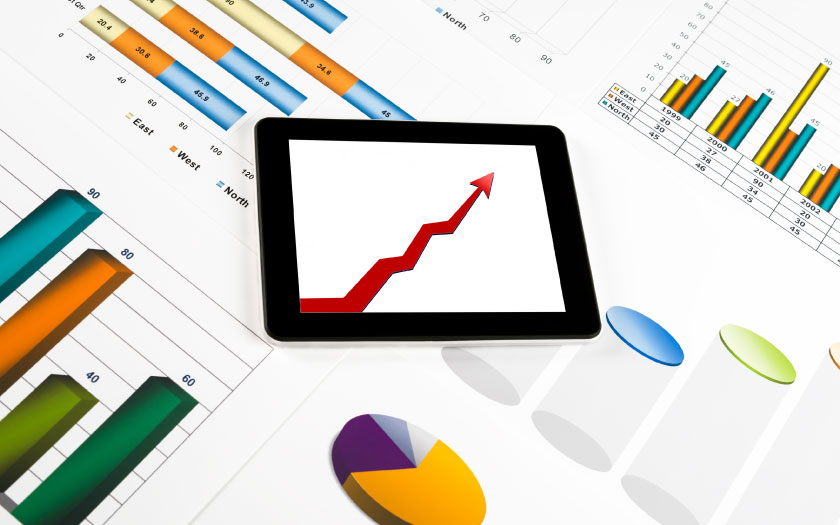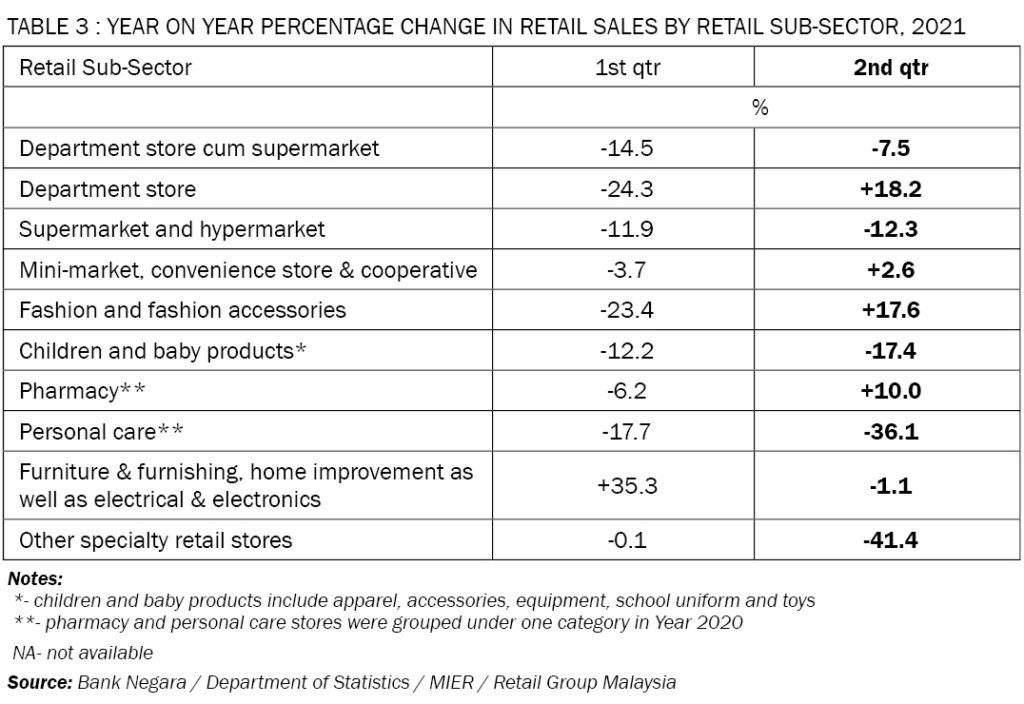PREAMBLE
Members of Malaysia Retailers Association (MRA) and Malaysia Retail Chain Association (MRCA) were interviewed on their retail sales performances for the second quarter as well as the rest of 2021.
Prolonged lockdowns this year and high daily positive cases have affected the ability of many Malaysian retailers to stay afloat. With the gradual relaxation of movement restrictions and the opening of more retail trades, retailers are struggling to catch sales for the remaining few months of this year.
LATEST RETAIL PERFORMANCE
For the second quarter of 2021, Malaysia retail industry recorded a positive growth rate of 3.4% in retail sales, as compared to the same period in 2020 (Table 1).
This latest quarterly result was worse than the estimate made by Retail Group Malaysia at +5.6% in June 2021.

The positive growth rate during the quarter was due solely to the low base effect a year ago. During the second quarter of 2020, Malaysia retail industry suffered a year-on-year decline of 30.9% because of business closures.
Retail performances during the second quarter of this year had been affected by a series of lockdowns.
Shopping traffic recovered when Movement Control Order (MCO) 2.0 ended in March 2021. Although Malaysia was under Conditional Movement Control Order (CMCO) during the first month of the second quarter, shopping malls in all major cities received large crowds on the first weekend after MCO 2.0 was lifted. Some tourist areas had also received good crowd during the weekends.
After surging daily confirmed cases, MCO 3.0 had been re-imposed from 3 May 2021 and ended on 31 May 2021. During this period, majority of retailers suffered from poor sales when Malaysian shoppers avoided enclosed places.
Started from 1 June 2021, Phase 1 of Full Movement Control Order (FMCO) ran for a period of 2 weeks. During this time, non-essential retailers had been ordered to shut down. Malaysians nationwide were asked to stay at home.
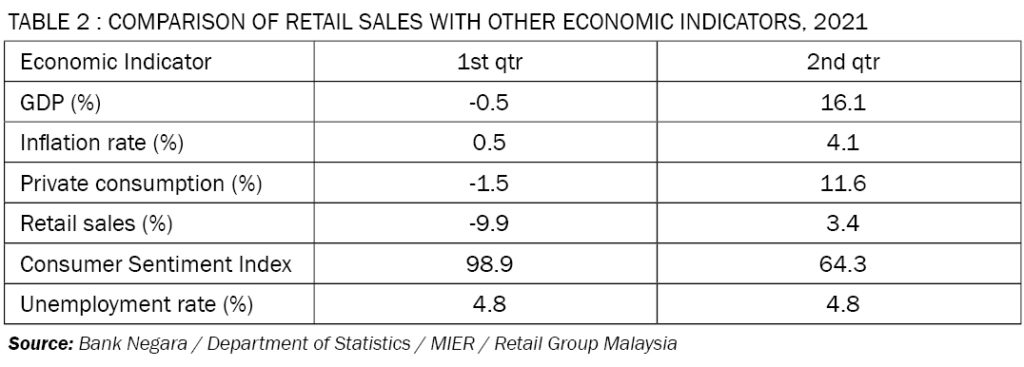
National Recovery Plan (NRP) in 4 phases was implemented from 15 June 2021. Similar to FMCO, non-essential retailers remained close and Malaysian consumers were asked to remain at home.
For the first 6 months of this year, the retail sale growth rate contracted by 4.4%, as compared to the same period a year ago.
COMPARISON OF RETAIL SALES WITH OTHER ECONOMIC INDICATORS
For the second quarter of 2021, Malaysia national economy expanded by 16.1% (Table 2, at constant prices), as compared to 3.4% for retail sales (at current prices).
This high growth rate was mainly due to the low base from the significant decline in economic activities a year ago. During the second quarter of 2020, Malaysia GDP growth rate was -17.1%.
The average inflation rate during the second quarter of 2021 rose sharply at 4.1%. CPI remained positive for the 5th consecutive month since February this year due to the lower base effect in 2020 as a result of the decline in fuel prices for private vehicles. During the second quarter, average price of Transport rose 23.2%. This was followed by Housing, Water, Electricity, Gas and Other Fuels at 3.2%.
Private consumption expanded by 11.6% during the second quarter of 2021. A year ago, it declined by 18.5% due mainly to movement control order.
During the second 3-month period, the Consumer Sentiment Index (by MIER) dropped drastically by 34.6 points. Tight household budget, rising prices and limited job prospects were the main concerns. It had remained below the 100-point threshold level of optimism for 11 consecutive quarters.
The unemployment rate during the second quarter of 2021 remained unchanged at 4.8%.
RETAIL SUB-SECTORS’ SALES COMPARISON
The performances of retail sub-sectors during the second quarter of 2021 were mixed. Numerous retail sub-sectors were severely affected during this period because their physical stores stayed shut for a long period of time.
Department Store cum Supermarket sub-sector recorded a negative growth rate of 7.5% during the second quarter of 2021, as compared to the same period a year ago.
On the other hand, retail business of Department Store sub-sector rebounded during second 3-month period of this year. After a huge dip in business during the first quarter, it grew by 18.2% during the subsequent quarter.
The Department Store sub-sector had been suffering from double-digit sale declines on quarterly basis since the virus pandemic started. It was the best performing retail sub-sector during the second quarter of this year.
Despite being allowed to open throughout the virus pandemic, the Supermarket and Hypermarket sub-sector was still faced with declining retail sales as compared to pre-covid-19 period. Its business contracted by 12.3% during the second quarter of 2021.
On the contrary, the Mini-Market, Convenience Store & Cooperative enjoyed a moderate growth rate of 2.6% in retail sales during the second quarter of this year.
During the second quarter of 2021, the Fashion and Fashion Accessories sub-sector managed to turn around with a growth rate of 17.6%. Similar to Department Store sub-sector, it was the first time this sub-sector registered a positive growth rate since the advent of the covid-19 pandemic in Malaysia.
The Children and Baby Products sub-sector recorded a decline of 17.4% in retail sale during the second 3 months of this year.
During the second quarter of this year, Pharmacy sub-sector reported a positive growth rate of 10.0%, as compared to the same period a year ago. This sub-sector was one of the few retail trades that remained open throughout the covid-19 crisis.
The Personal Care sub-sector registered another poor retail result with -36.1% in growth rate during the second 3-month period of this year. Its physical stores stayed shut for most part of the second quarter.
The Furniture & Furnishing, Home Improvement as well as Electrical & Electronics sub-sector reported a decline in growth rate of 1.1% during the second quarter of 2021.
The Other Specialty Stores sub-sector (including photo shop, fitness equipment store, sporting goods’ store, store retailing musical instrument, optical store, shop selling baking ingredient as well as direct selling firm) suffered a large drop in retail sale (-41.4%) during the second quarter of 2021, as compared to the same period last year. This was the worst performing retail sub-sector during the second quarter.
NEXT 3 MONTHS’ FORECAST
Members of the two retailers’ association project an average growth rate of -15.1 during the third quarter of 2021 (Table 4). Physical stores of majority of retail trades were shut during the first half of third quarter. Except for operators of mini-market, convenience store and cooperative, retailers in all retail sub-sectors foresee downward movement in their sales for the next 3 months.
The department store cum supermarket operators are expecting their sales to worsen with a negative growth of 25.5% for the third quarter of this year.
After a temporary rebound, the department store operators are expecting their businesses to decline with a negative growth rate of 11.2% for the third 3-month period of this year.
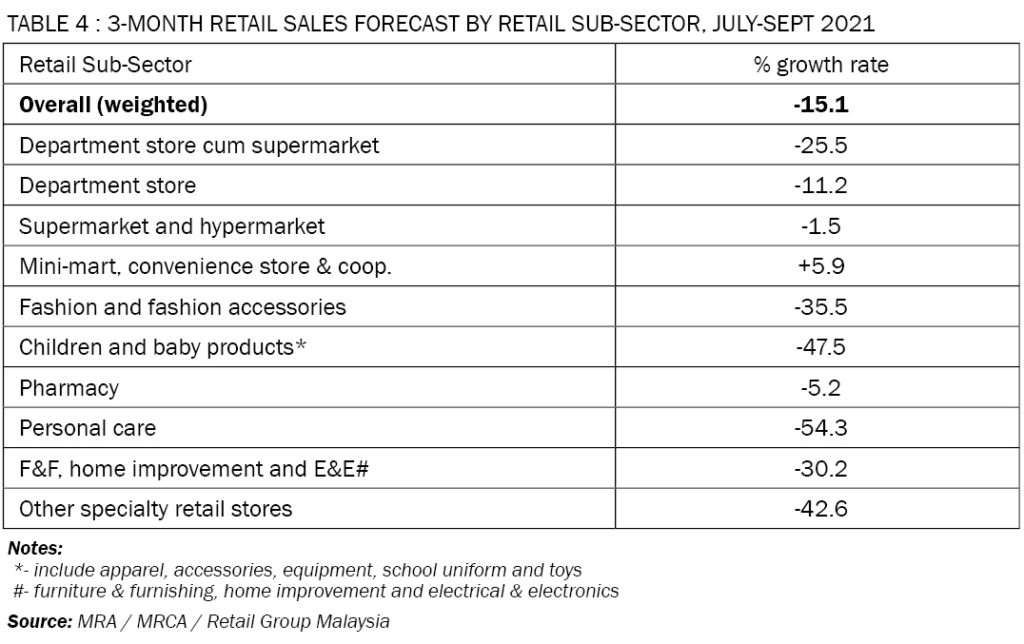
Although this sub-sector remains the least affected among the retail sub-sectors during this difficult period, supermarket and hypermarket operators will see only slight improvement in their businesses in the next 3 months. They expect to remain in the red zone with a -1.5% growth rate for the third quarter of 2021.
Operators of mini-market, convenience store and cooperative are anticipating a mild recovery in their sales with a growth rate of 5.9% during the third 3-month period of this year.
Retailers in the fashion and fashion accessories sector expect their businesses to suffer greatly with -35.5% in growth rate during the third quarter of 2021, as compared to the same period a year ago.
Retailers selling children and baby products are anticipating their businesses to sink further with a -47.5% in growth rate during the third 3 months of this year.
Pharmacy operators are also less hopeful of their retail sales during the third quarter of this year with a growth rate of -5.2%.
Retailers in the personal care sub-sector are expecting their businesses to plummet by 54.3% for the third quarter of 2021. This will be the worst performer among the retail sub-sectors during this period.
Operators of furniture & furnishing, home improvement as well as electrical & electronics are expecting to report their average growth at -30.2% during the third 3 months of this year.
Retailers in other specialty stores sub-sector (including photo shop, fitness equipment store, sporting goods’ store, store retailing musical instrument, optical store, shop selling baking ingredient as well as direct selling firm) are equally pessimistic for this period. They expect their businesses to slide by 42.6% during the next 3-month period.
THE REST OF YEAR 2021
In June this year, Retail Group Malaysia (RGM) estimated a 4.0% growth rate in retail sale for 2021. However, this projection needs to revise downwards again taking into consideration the lower growth in second quarter result and the revision of third quarter estimate.
RGM revises Malaysia annual retail industry growth rate for 2021 from 4.0% to 0.8% (Table 5).
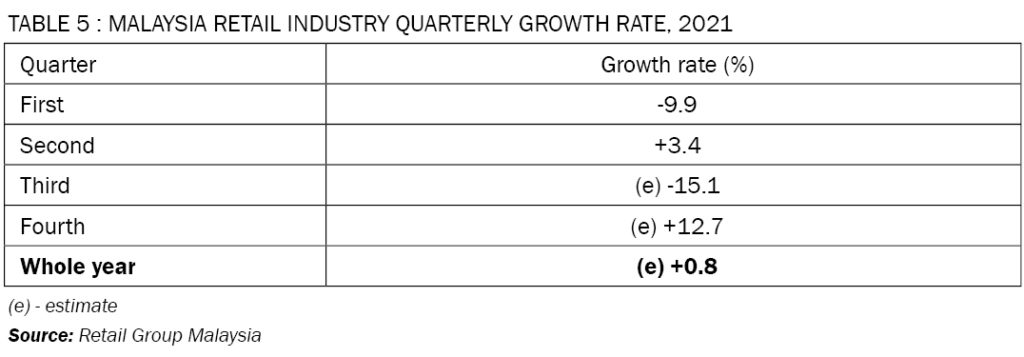
Enhanced Movement Control Order (EMCO) was enforced in large part of Selangor and selected locations in Kuala Lumpur from 3 July and ended on 16 July. Retail businesses in the largest retail market of Malaysia were badly hit during this critical period.
From 16 August 2021, more retail businesses under National Recovery Plan (NRP) Phase 1 have been allowed to open. They include fashion shop, jewellery shop, electrical & electronics shop, furniture shop, sports shop, car accessories shop, hair salon, barber shop and car showroom.
When the government relaxed restrictions on number of passengers in a vehicle as well as the limit of travelling distance on 21 August 2021, shopping traffic in major shopping centres gradually returned.
Cinema, entertainment centre and beauty salon have been allowed to open from 9 September 2021 for fully vaccinated individuals. However, most of these businesses only began opening to public a week or more later after finalising the complete SOPs with the relevant government departments.
Recreational centres have been allowed to resume their operations from 10 September 2021 for their fully vaccinated customers.
Gyms have been allowed to open from 18 September 2021 for their fully vaccinated members.
Klang Valley (Kuala Lumpur, Selangor and Putrajaya) was upgraded to NRP Phase 2 on 10 September 2021. More relaxations, including dine-in, have been allowed for fully vaccinated individuals.
Effective 17 September 2021, more retail businesses have been allowed to open for states under Phase 1 of NRP. They include personal care shop, toys store, antique shop, outdoor shop, tobacco shop, carpet shop, used items store, photography shop, souvenirs and craft shop, nursery as well as florist.
Starting from 1 October 2021, spa, wellness centre and massage centre may open to fully vaccinated public.
Interstate travel ban is expected to be relaxed from middle of October 2021 after 90% of the adult population has been fully vaccinated. Domestic tourism will bring more sales to retailers that have been depending on tourism spending.
Travel bubbles with selected countries will likely to begin towards end of this year. Malaysia will witness rising foreign tourist arrivals only from first half of next year.
RGM expects retail industry to gain momentum on its recovery by the end of this year. For the fourth quarter of 2021, RGM maintains its estimate at 12.7%, as compared to the same period a year ago.
Over the last few months, there have been historical high daily positive cases and high death rates. These records may remain when Malaysian government begins to treat Covid-19 pandemic as an endemic by end of October. Despite high vaccination rate among adult population, these situations are worrisome. The danger of another total lockdown in the near future are haunting Malaysian retailers.
FOOD & BEVERAGE SECTOR
Started from 5 March 2021, Malaysia transited into Conditional Movement Control Order (CMCO). During this period, F&B outlets were allowed to operate as usual with social distancing measures.
CMCO ended on 3 May 2021 and MCO was re-implemented when daily covid-19 cases climbed sharply. Dine-in was forbittened again during MCO 3.0.
Commencing from 1 June 2021, FMCO was introduced that required majority of Malaysians to stay home. National Recovery Plan (NRP) was implemented from 15 June 2021. Similar to FMCO, dine-in was not allowed.
Food & Beverage Outlets (Cafe and Restaurant) recorded a negative growth rate of 10.9% during the second quarter of 2021, as compared to the same quarter a year ago (Table 6).

On the other hand, Food & Beverage Outlets (Take-Away, Kiosk and Stall) climbed by 37.5% during the second quarter of 2021, as compared to the same period one year ago.
Started from 10 August 2021, dine-in has been allowed for all foods & beverages outlets under NRP Phase 2 or higher states.
From 20 August 2021, dine-in has been allowed for fully vaccinated individuals in states under Phase 1 of NRP. Fully vaccinated parents are allowed to take their children who are under 17-years-old to dine with them.
Beginning of 23 September 2021, foods & beverages establishments have been allowed to open from 6am to 12am daily for all phases under the NRP.
Cafe and restaurant operators are foreseeing their businesses to dip further for the third 3 months of this year. They expect their food business to decline by 30.2% as compared to the same period last year.
On the other hand, food and beverage kiosk and stall operators are anticipating their businesses to grow marginally by 1.5% during the third quarter of 2021.
Footnote:
- This report is provided as a service to members of MRA, MRCA and the retail industry. It provides industry data that give retailers better analytical tools for running their retail businesses.
- This report is not allowed to be reproduced or duplicated, in whole or part, for any person or organisation without written permission from Malaysia Retailers Association, Malaysia Retail Chain Association or Retail Group Malaysia.
- Retail Group Malaysia is an independent retail research firm in Malaysia. The comments, opinions and views expressed in this report are of writer’s own, and they are not necessary the comments, opinions and views of MRA, MRCA and their members.
- For more information, please write to tanhaihsin@yahoo.com.

